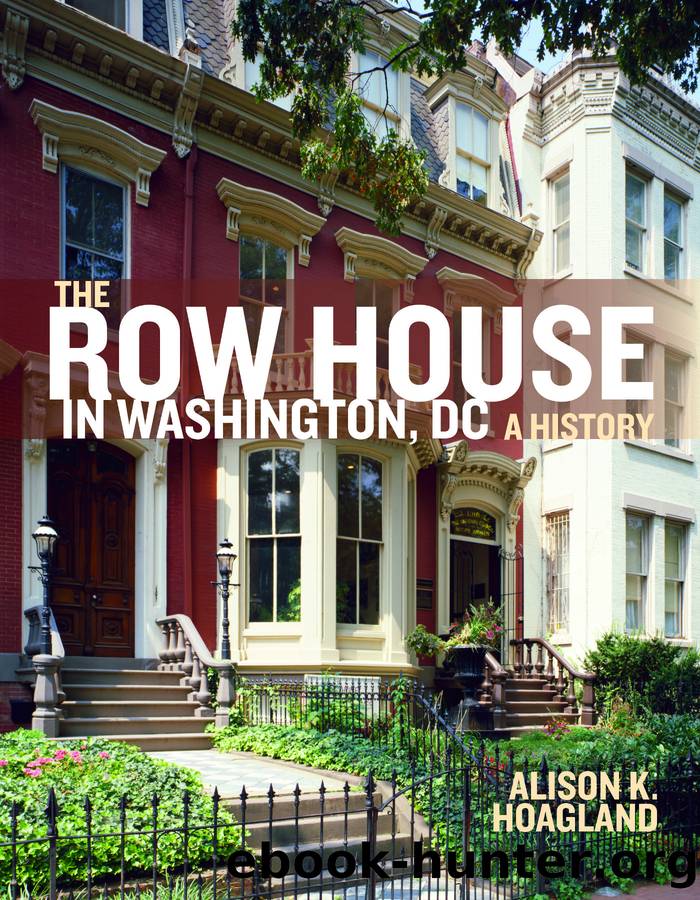The Row House in Washington, DC by Alison K. Hoagland;

Author:Alison K. Hoagland; [Hoagland, Alison K.]
Language: eng
Format: epub
Tags: ARC005000 ARCHITECTURE / History / General
Publisher: Lightning Source Inc. (Tier 3)
Figure 82. Row houses, 2700 block of Woodley Place NW. In 1924 Joseph Shapiro came under investigation by a congressional committee for price gouging in the development of row houses designed by George Santmyers on Woodley Place NW. The committee concluded that Shapiro was reaping a profit of 47.5 percent, but he proceeded undeterred. (Photograph by the author, 2022)
The houses raised the suspicion of the Senate committee because of their cost. On the building permit, J. B. Shapiro estimated the cost of construction at a little more than $20,000 apiece. This was so outrageous that the building inspector called Shapiro in and had him change the estimate to $9,200. Shapiro was selling the houses for $12,950. The committee estimated the cost of land at $800 per lot, making the total cost of each house $10,000, for which Shapiro was getting a 29.2 percent profit. The committee then deducted the financing and selling costs and determined that the true cost of the house and lot was $8,753, which meant that Shapiro was making 47.5 percent profit. Most of the committeeâs ire was directed at overpriced apartment buildings resulting in excess rents and worthless mortgages, and Shapiro proceeded undeterred. By the time of the committeeâs hearing, he had sold 23 of the 32 houses. Two months later he had sold most of them and started construction on 36 more.44
Another aspect of the vertical organization of operative builders was the ability to have a large staff providing technical expertise, from professionals in financing and advertising to land acquisition and engineering. Operative builders continued to subcontract the work of construction, maintaining flexibility, yet they also had some craftsmen on staff, as evidenced by this classified ad: âHelp wanted: PainterâLive young man experienced in operative builderâs painting; references required; permanent position and good future for right man.â When they subcontracted, the builders chose between union or nonunion workers, with the unionized workers perceived as more professional and capable. But unionized workers were a thorn in the side of operative builders; the Operative Builders Association was formed, in part, to deter unions from demanding increased wages. An article in Architects and Builders Journal, advocating an open shop and quoted extensively in the Evening Star in 1907, stated, âFor years Mr. Wardmanâs firm had temporized with the unions, granted concessions, yielded to demands until the power of reasonable endurance had been passed, employing every means to avoid antagonism, all to no purpose, and finally it cast the irksome burden from its shoulders, threw off the shackles and was free.â Wardman âhas boldly declared that in the future he will have nothing to do with organized labor in the building trades, and that he will conduct his business on the principle of the open shop. Mr. Wardman has found no difficulty in securing competent workmen. There is not a union man employed on any of his contracts, yet he is getting satisfactory results, his work is progressing, harmony prevails and the men are content.â That same year, the
Download
This site does not store any files on its server. We only index and link to content provided by other sites. Please contact the content providers to delete copyright contents if any and email us, we'll remove relevant links or contents immediately.
Kathy Andrews Collection by Kathy Andrews(11706)
The remains of the day by Kazuo Ishiguro(8787)
Paper Towns by Green John(5061)
Spare by Prince Harry The Duke of Sussex(5052)
The Body: A Guide for Occupants by Bill Bryson(4950)
Industrial Automation from Scratch: A hands-on guide to using sensors, actuators, PLCs, HMIs, and SCADA to automate industrial processes by Olushola Akande(4910)
Machine Learning at Scale with H2O by Gregory Keys | David Whiting(4101)
Be in a Treehouse by Pete Nelson(3922)
Never by Ken Follett(3760)
Harry Potter and the Goblet Of Fire by J.K. Rowling(3758)
Goodbye Paradise(3709)
Into Thin Air by Jon Krakauer(3288)
The Remains of the Day by Kazuo Ishiguro(3279)
The Cellar by Natasha Preston(3241)
The Genius of Japanese Carpentry by Azby Brown(3208)
Fairy Tale by Stephen King(3192)
120 Days of Sodom by Marquis de Sade(3160)
The Man Who Died Twice by Richard Osman(2977)
Drawing Shortcuts: Developing Quick Drawing Skills Using Today's Technology by Leggitt Jim(2974)
